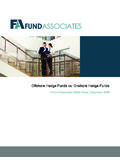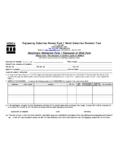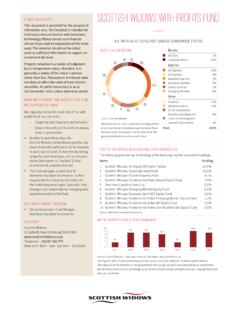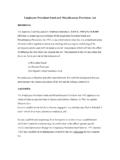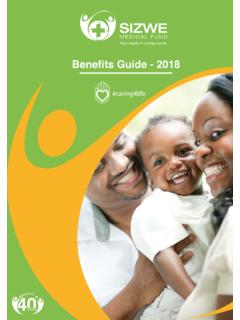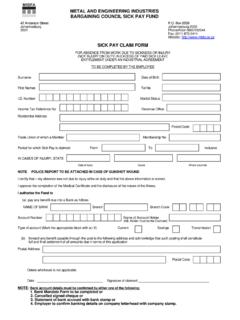Transcription of Introducing ancillary own-fund items - EY
1 Introducing ancillary own- fund items Contents 03 Introducing ancillary own- fund items 04 What are ancillary own funds? 04 Common, practical issues 05 Regulatory approvals 06 Other considerations 06 Where can EY help? 06 Contacts 2 Introducing ancillary own-funds items Introducing ancillary own- fund items ancillary own funds (AOFs) are one of the major innovations under Solvency II, being unfunded capital instruments eligible to cover Solvency II capital requirements. They are an alternative to funding available capital with equity or hybrid debt. Many insurance companies are looking at AOFs as part of their capital management strategies. In particular, they want to see how AOFs can be used as intragroup capital instruments, and how AOFs interact with other key aspects of group capital structure, including risk appetite, cash flows and IFRS reporting. EY is working with a number of insurers across Europe to optimize their group capital structures and to see how AOFs fit within the overall toolkit.
2 This paper discusses the application and benefits of AOFs common issues that companies face, and how EY can help in dealing with those issues. Introducing ancillary own-funds items 3. What are ancillary Common, own funds? practical issues Solvency II allows insurers to meet their solvency capital The majority of AOFs are expected to be internal structures because requirement with a range of capital instruments. Own-funds can they present the greatest advantages. However, some of the issues be composed of equity, hybrid debt and deferred tax assets. insurers face when using external structures include the following: The Solvency II regulations also introduce a new unfunded instrument: AOFs. AOFs are committed but unpaid lines of capital. The lack of conditionality on the ability to call down the capital A counterparty (the donor) agrees to increase its investment in may mean an external investor would set the price at the an insurer (the recipient).
3 Under Solvency II, capital credit can be lowest possible level. As a result, the structure may not be obtained for the monetary amount of the AOF once it is approved cost-effective because of the high option premium. by the regulator, and does not need to be drawn. Tier-2 AOFs are the most efficient, which implies that the To be eligible as AOF the capital needs to be callable by the underlying instrument should be equity or hybrid tier 1. recipient on demand with no conditionality attached, such as event Both alternatives give rise to challenges. An equity instrument triggers based on a certain solvency ratio. The underlying item may lead to a dilution of ownership or control, while the needs to be eligible basic own- fund capital. structure of a hybrid is likely to be more complicated. Solvency II splits components of own-funds into three tiers and sets Proving willingness and ability to pay may be a higher burden for limits as to their composition.
4 Tier 1 capital is the highest ranking with the greatest loss absorbing capacity, such as equity. Tier 2 external investors or more expensive to the AOF recipient if it is own-funds are composed of hybrid debt and tier 3 of deferred tax collateralized either with cash or a letter of credit (LOC). assets. Solvency capital requirements needs to be met with at least 50% tier 1 capital. Tier 3 capital is limited to 15% of the solvency capital requirement. Combined tier 2 and tier 3 capital cannot be used to cover in excess of 50% of the solvency capital requirement. An AOF is notched down one tier from the underlying basic own fund item. For example, contingent equity is tier 2; however, under AOF's contingent tier 2 becomes tier 3. There is currently limited precedent for AOFs as these items are a new concept under Solvency II. But, the three potential benefits that an AOF provides are as follows. Unpaid: allows centralization of liquidity within an insurance group Flexibility: offers potentially fewer restrictions on extraction or cancellation than paid-in instruments Capital buffer: provides a means to fund a capital buffer within a subsidiary Note: We do not believe an LOC on its own would be eligible as an AOF because it is a form of collateralization rather than a capital instrument.
5 4 Introducing ancillary own-funds items Regulatory approvals The EU implementing regulation (Commission Implementing Term sheet for the AOF. Regulation 2015/499) stipulates the documentation required as Consideration of disincentives to call well as the time regulators have to grant approvals. A legal opinion stating that the AOF is legally binding and Regulators have a 30-day application review period to establish enforceable whether the application is complete. There is a three-month normal approval window from the receipt of a complete An assessment of when the AOF recipient would expect to call the application, which stretches to six months in exceptional instrument circumstances. An application must include the following In addition to this list of documentation some regulators, such as documentation: the Central Bank of Ireland have introduced their own contribution Medium-term capital plan agreement templates to be completed as part of the application.
6 Assessment of the: In terms of ongoing monitoring on each reporting date, the board Economic substance of the AOF and its loss-absorbing capacity of the recipient will need to confirm to its regulator that there have been no changes in the structure of the agreement or status Counterparty's ability and willingness to pay the call on the AOF of the counterparty. At any time , regulators have the power to Counterparty's ability and willingness to pay multiple review the ability and willingness of the counterparty to pay the simultaneous calls from other group entities called-up amount. Other Article 308a (Directive 2009/138/EC) approvals pending The documentation and approval process is less clear for the or foreseen, such as transitional measures or full or partial entity providing the AOF. However, we would anticipate a parallel internal models discussion with the counterparty's regulator. Details of any arrangements in place to offset the counterparty's Our expectation is that regulators will be cautious given the lack credit risk of precedents.
7 They may also be more unwilling to grant approvals where the counterparty is outside of the European Economic Area Demonstration of a track record of the counterparty meeting its and in a non-equivalent jurisdiction. There is value in creating obligations precedents and a track record, such as a small test trade as proof of Process for monitoring the ongoing credit risk of the concept. counterparty Records that the application has received the required governance approvals within the company Introducing ancillary own-funds items 5. Other Where can considerations EY help? What implications are there of eliminating intragroup transactions We have leading expertise on all aspects of capital optimisation within the Solvency II group consolidated solvency ratio. under Solvency II. AOF should be considered along with a range of other options to promote capital efficiency. We have a track What the valuation is of an AOF commitment on the solo balance record of implementing these solutions including, among others, sheet of an insurance entity.
8 Internal reinsurance, converting operating entities to branches, How the lack of conditionality is incorporated into group restructuring asset portfolios and Introducing alternative funding liquidity management and group risk appetite. structures. What the duration is of the committed period and interaction With specific reference to AOF: with the required minimum tenor of the underlying Preparatory phase: We can assist with structuring the term sheet own- fund instrument. for the AOF from a regulatory and tax perspective. This will be AOFs are not included in the definition of basic own-funds more complicated if the underlying instrument is hybrid tier-1. and therefore cannot be used to cover the minimum debt rather than equity. capital requirement. Regulatory application: We can advise you on regulatory analysis Interaction with other credit stakeholders and the disclosure and review any documents the group entities prepare before they is required, for example, with rating agencies, lending banks are shared with the regulators, and assist with capital planning.
9 And swap counterparties. Other impacts: In tandem with the preparatory phase and the Pricing will not be straightforward and, if the instrument regulatory application, we can advise on the impact an AOF. is cross-border, transfer pricing and tax considerations may have from a tax and disclosure perspective. We anticipate will rise in importance. insurers may wish to seek external views on transfer pricing, which is also something we can help document. How the AOF interacts with an operating company's existing capital structure and Solvency II tiering limits, , hybrid tier 1. can only be 20% of total tier 1; tier 2 and tier 3 capital can only be used to cover 50% of the solvency capital requirement; and tier 3. capital can only cover 15% of the solvency capital requirement. The AOF, by increasing intercompany financing links, may have implications for the complexity of insurer's recovery and resolution planning.
10 The risk appetite of the recipient may need to be reevaluated given that it has access to these funds on its balance sheet. 6 Introducing ancillary own-funds items Contacts Europe Simon Woods +44 20 7980 9599. Jeff Davies +44 20 7951 7227. Asia-Pacific Jonathan Zhao +85 2612 48127. Latin America Nuno Andre Vieira +55 11 2573 3098. Fernando Belaunzaran +52 5511 016468. United States Doug French +1 212 773 4120. Introducing ancillary own-funds items 7. EY | Assurance | Tax | Transactions | Advisory About EY. EY is a global leader in assurance, tax, transaction and advisory services. The insights and quality services we deliver help build trust and confidence in the capital markets and in economies the world over. We develop outstanding leaders who team to deliver on our promises to all of our stakeholders. In so doing, we play a critical role in building a better working world for our people, for our clients and for our communities.










